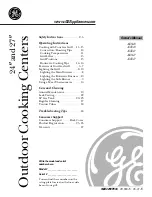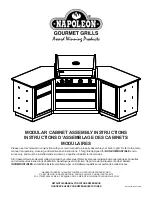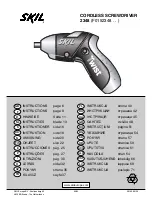
GB
27
• Remove any adjusting key or wrench before
turning the power tool on.
A wrench or a key
left attached to a rotating part of the power tool
may result in personal injury.
• Do not overreach. Keep proper footing and
balance at all times.
This enables better control
of the power tool in unexpected situations.
• Dress properly. Do not wear loose clothing or
jewellery. Keep your hair, clothing and gloves
away from moving parts.
Loose clothes, jewel-
lery or long hair can be caught in moving parts.
• If devices are provided for the connection of
dust extraction and collection facilities,
ensure these are connected and properly
used.
Use of these devices can reduce dust-
related hazards.
Power tool use and care
• Do not force the power tool. Use the correct
power tool for your application.
The correct
power tool will do the job better and safer at the
rate for which it was designed.
• Do not use the power tool if the switch does
not turn it on and off.
Any power tool that can-
not be controlled with the switch is dangerous
and must be repaired.
• Disconnect the plug from the power source
and/or the battery pack from the power tool
before making any adjustments, changing
accessories, or storing power tools.
Such
preventive safety measures reduce the risk of
starting the power tool accidentally.
• Store idle power tools out of the reach of chil-
dren and do not allow persons unfamiliar with
the power tool or these instructions to oper-
ate the power tool.
Power tools are dangerous
in the hands of untrained users.
• Maintain power tools. Check for misalign-
ment or binding of moving parts, breakage of
parts and any other condition that may affect
the power tool’s operation. If damaged, have
the power tool repaired before use.
Many
accidents are caused by poorly maintained
power tools.
• Keep cutting tools sharp and clean.
Properly
maintained cutting tools with sharp cutting edges
are less likely to bind and are easier to control.
• Use the power tool, accessories and tool bits
etc. in accordance with these instructions,
taking into account the working conditions
and the work to be performed.
Use of the
power tool for operations different from those
intended could result in a hazardous situation.
Battery tool use and care
• Recharge only with the charger specified by
the manufacturer.
A charger that is suitable for
one type of battery pack may create a risk of fire
when used with another battery pack.
• Use power tools only with specifically desig-
nated battery packs.
Use of any other battery
packs may create a risk of injury and fire.
• When battery pack is not in use, keep it away
from other metal objects, like paper clips,
coins, keys, nails, screws or other small
metal objects, that can make a connection
from one terminal to another.
Shorting the bat-
tery terminals together may cause burns or a fire.
• Under abusive conditions, liquid may be
ejected from the battery; avoid contact. If
contact accidentally occurs, flush with water.
If liquid contacts eyes, additionally seek med-
ical help.
Liquid ejected from the battery may
cause irritation or burns.
• Do not open the rechargeable battery.
The
rechargeable battery can be damaged by
improper handling.
• Do not expose the rechargeable battery to
heat, fire, water and humidity.
There is a dan-
ger of explosion.
• Vapours may escape in case of damage or
improper use of the rechargeable battery.
Provide good ventilation and seek medical
assistance in case any symptoms occur.
The
vapours can irritate your respiratory tract and
cause illness.
• Never attempt to charge non-rechargeable
batteries.
There is a danger of fire and explo-
sion.
• The rechargeable battery may only be used in
conjunction with this electrical tool.
Other
electrical tools can overload and hence damage
the rechargeable battery.
• Only chargers approved by the manufacturer
with the values stated on the type plate of the
rechargeable battery may be used.
The use of
deviating chargers can pose the risk of injuries
and material damage caused by exploding bat-
teries.
Safety information for chargers
• Keep the charger away from rain and wet.
The risk of electric shock increases if water pen-
etrates a charging device.
• Keep the charging device clean.
Soiling
involves the danger of an electric shock.
• Check the charging device, cable and plug
before each use.
Do not use the charging
device if you detect any damage.
• Do not open the charging device yourself and
only have it repaired by qualified profession-
als and only with original spare parts.
Dam-
aged charging devices, cables and plugs
increase the risk of electric shock.
• Do not use the charging device on easily
flammables items (e.g. paper, textiles etc.) or
in combustible atmospheres.
There is a dan-
ger of fire due to the heating of the charging
device during the charging process.
• Supervise children and make sure that they
do not play with the charger. Children and
persons with mental or physical restrictions
may only use the charger under supervision
or after having been instructed how to use it.
Careful instruction reduces the risk of incorrect
operation and injuries.
Содержание A-BS-20-E Set
Страница 3: ...3 3 4 5 1 2 7 6 1 2 8 9 10 11 12 ...
Страница 4: ...4 10 3 4 11 ...
Страница 88: ...GR 88 196055 Φ ń Ńń παńα α 196053 łń łπα αφ ń Ń ł ŃυŃ łυ φ ń Ń ȋλ πλκρσ θńκμ ȎιΪλńβηα ...
Страница 115: ...115 RU ϗϴЄϴЁІϼϽЁЏϽ ІϴϿЂЁ ё ϗϴЄϴЁІϼϽЁЏϹ ЇЅϿЂ ϼГ 1 2 24 3 ...
Страница 116: ...116 4 20 13109 97 ...
Страница 121: ...121 ...
Страница 122: ...122 ...
Страница 123: ...123 ...
















































